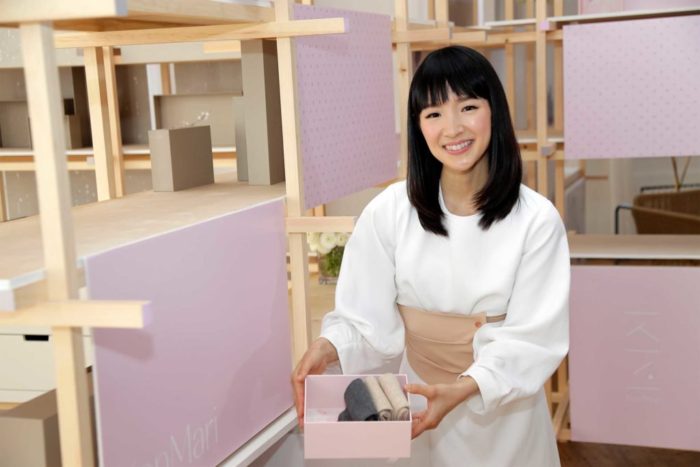Published in the Nikkei Asian Review 13/2/2019
There are few people whose names become verbs, William Hoover being the most famous. Now a Japanese woman in her mid-30s has joined that select group. Marie Kondo, the “de-cluttering guru,” is suddenly everywhere and the media is full of advice on how to “Kondo” your kitchen, your weekly shopping trip and your kids’ bedrooms.
“Konmari,” as she is known in her own country, first became a publishing sensation in Japan and then internationally. “The Life-Changing Magic of Tidying Up: the Japanese Art of Decluttering and Organizing” has topped the New York Times bestsellers’ list and sold 5 million copies globally. But it is her Netflix reality TV series, “Tidying Up With Marie Kondo,” that has turned her into an internet sensation who has spawned oodles of memes on Instagram and Twitter.
In that show she descends into the tat-filled homes of ordinary Americans like a being from another, more advanced planet. Equipped with an interpreter and an eerily invincible smile, she “sparks joy” in the home-makers’ benighted lives by having them get rid of possessions they don’t really need. The result is a quasi-religious transformation, as they look forward to brighter, more orderly futures in their now mess-free living spaces.
The time was ripe for the coming of Kondo. In the developed world we live in an era of deflation – where the real price of almost everything has gone down, where repairing gadgets and clothes makes no economic sense, where poorer people often suffer from obesity, not emaciation.
In abstract areas too – such as politics, art, music and academic studies – increasing supply seems only to bring bloat and deteriorating quality. Helplessly drowning in “stuff”, we realise that “more” has meant “less.” Now into this maelstrom of superfluity steps Kondo, as neat and minimalist as her philosophy.
I can see the appeal. As I write, I am surrounded by piles of coffee-ringed papers, mugs full of pens that have ceased to work and shelves of books, many of which I will likely never open again. What if I “Kondo-ed” the whole lot? According to her prescription, only 30 books would remain. Any objects that do not bring me joy – such as that box of old shoes – would have to go.
Perhaps I should “Kondo” my human relationships too, narrowing down my circle of friends to 30 joy-bringers. Come to think of it, the whole planet could do with some decluttering. Reducing human numbers to, say, 3 billion would surely be an aesthetic improvement, as well as environmentally more sustainable. If Marie Kondo were President of the World, she could probably sort that out for us.
Japanese-ness is a key part of the Kondo mystique. She evokes the austere strand of Japanese aesthetics exemplified by Zen Buddhism, the tea ceremony and Noh theatre. Indeed, Buddhist monk Kenko Yoshida could be considered a “de-cluttering guru” of the fourteenth century. In Essays in Idleness, he observes as follows.
“Things which seem in poor taste: too many personal effects cluttering up the place where one is sitting; too many brushes in an ink-box; too many Buddhas in a family temple; too many stones and plants in a garden; too many children in a house; too many words on meeting someone; too many meritorious deeds recorded in a petition.”
Austerity, however, is not the only strand in Japanese aesthetics. The extravagance of Kabuki contrasts with Noh; the roaring din of a pachinko parlor with the Zen garden at Ryoanji; the friendly yell of irasshaimase (“welcome”) at your local yakitori joint with the hallowed atmosphere of Jiro’s Michelin-starred sushi-ya. Many Japanese homes, far from being models of tasteful restraint, are crammed to bursting point with bric-a-brac, as captured in Kyoichi Tsuzuki’s eye-opening photo book, “Tokyo Style.”
The reality is that in any society a balance is necessary between imposed order and creative anarchy. Recent trends suggest that the former has the upper hand, as organizations get tied up in health and safety rules and compliance requirements.
In Tokyo, the glorious chaos of districts like Shimo Kitazawa is being replaced by coldly impersonal new developments. “Kondo-ing” the urban environment may end up destroying something precious.
“Will the city be any fun?” was the key issue for the great urbanologist Jane Jacobs, whose philosophy was the polar opposite of Kondo’s. The same question could be posed for homes, and indeed many other aspects of human experience too.
Some of us need clutter, even find it inspirational. Unlike Kenko Yoshida in his mountain hut, I am not a hermit. I keep my shelves of books and piles of CDs and, yes, DVDs and LPs because I don’t know if or when I might need them. It may be a mess, but it’s my mess and it took me a lot of time and effort to create it.


